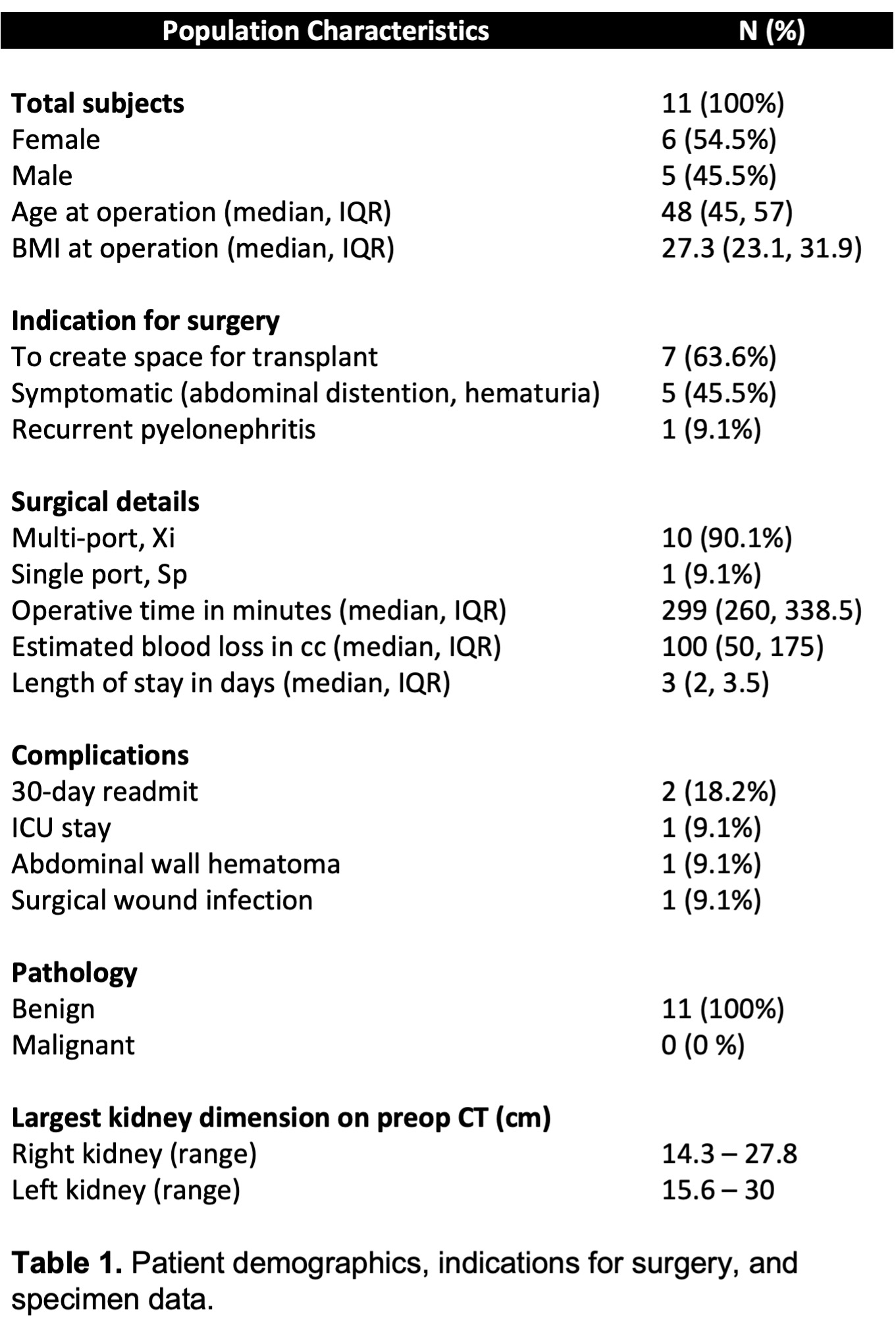Back
Poster, Podium & Video Sessions
Moderated Poster
MP36: Renal Transplantation & Vascular Surgery
MP36-17: Robotic Bilateral Nephrectomy for Large Kidneys with Adult Polycystic Kidney Disease with Da Vinci Xi and Da Vinci SP
Sunday, May 15, 2022
7:00 AM – 8:15 AM
Location: Room 228
Hanson Zhao, Lior Taich, John M. Masterson*, Aurash Naser-Tavakolian, Hayley Johnson, Reiad Najjar, Irene Kim, Amit Gupta, Los Angeles, CA

John M. Masterson, MD
Cedars-Sinai Medical Center
Poster Presenter(s)
Introduction: Autosomal dominant polycystic kidney disease (ADPKD) is the most common hereditary kidney disorder. Approximately 50% of patients with ADPKD have end stage renal disease (ESRD) by age 60. Native nephrectomy in ADPKD is historically an open procedure with complication and mortality rates of 38% and 5% respectively. In this study, we discuss our technique and review our experience with synchronous robotic bilateral nephrectomy for large kidneys in ADPKD with the Da Vinci XI and Da Vinci Single Port platforms (Intuitive Surgical, Sunnyvale, CA).
Methods: We performed a retrospective review of all robotic bilateral nephrectomy cases from January 2020 to October 2021. Demographic data and peri-operative details including preoperative CT scans, indication for nephrectomy, and renal function were collected. We also collected post-op course data and final specimen data details.
Results: Eleven cases were identified as synchronous robotic bilateral nephrectomies during the study period. Patient demographics, indications for surgery, and specimen data are outlined in table 1. The largest kidney removed measured 30cm in largest dimension on preoperative imaging. Median operating time from incision to closure was 299 minutes (IQR 260, 339). Median estimated blood loss was 100cc (IQR 50, 175). Two patients were transfused intra-operatively, one with autologous blood, and one whose preoperative hemoglobin was 8.8 g/dl; median pre- and post-operative hemoglobin was 11.3 and 9.7 respectively. The median length of stay was 3 days (IQR 2, 3.5). There were no intra-operative complications. Post-operative complications included one incisional hematoma, and one superficial wound infection. One patient was admitted to the surgical ICU post operatively for ventilatory support. Two patients were readmitted within 30 days of surgery – one for a superficial wound infection and one for delirium. Four patients successfully underwent kidney transplantation with a median 95 days (IQR 81 to 108) after bilateral nephrectomy.
Conclusions: The robotic approach to bilateral native nephrectomy for ADPKD should be considered when native nephrectomies are indicated. The operative times and outcomes compare favorably to prior series and this technique works even for very large kidneys.
Source of Funding: None

Methods: We performed a retrospective review of all robotic bilateral nephrectomy cases from January 2020 to October 2021. Demographic data and peri-operative details including preoperative CT scans, indication for nephrectomy, and renal function were collected. We also collected post-op course data and final specimen data details.
Results: Eleven cases were identified as synchronous robotic bilateral nephrectomies during the study period. Patient demographics, indications for surgery, and specimen data are outlined in table 1. The largest kidney removed measured 30cm in largest dimension on preoperative imaging. Median operating time from incision to closure was 299 minutes (IQR 260, 339). Median estimated blood loss was 100cc (IQR 50, 175). Two patients were transfused intra-operatively, one with autologous blood, and one whose preoperative hemoglobin was 8.8 g/dl; median pre- and post-operative hemoglobin was 11.3 and 9.7 respectively. The median length of stay was 3 days (IQR 2, 3.5). There were no intra-operative complications. Post-operative complications included one incisional hematoma, and one superficial wound infection. One patient was admitted to the surgical ICU post operatively for ventilatory support. Two patients were readmitted within 30 days of surgery – one for a superficial wound infection and one for delirium. Four patients successfully underwent kidney transplantation with a median 95 days (IQR 81 to 108) after bilateral nephrectomy.
Conclusions: The robotic approach to bilateral native nephrectomy for ADPKD should be considered when native nephrectomies are indicated. The operative times and outcomes compare favorably to prior series and this technique works even for very large kidneys.
Source of Funding: None


.jpg)
.jpg)